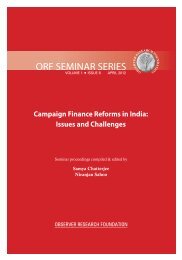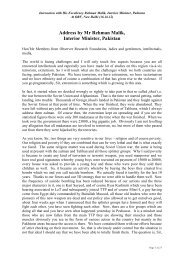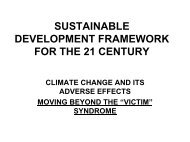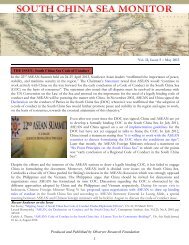ORF ENERGY NEWS MONITOR - Observer Research Foundation
ORF ENERGY NEWS MONITOR - Observer Research Foundation
ORF ENERGY NEWS MONITOR - Observer Research Foundation
You also want an ePaper? Increase the reach of your titles
YUMPU automatically turns print PDFs into web optimized ePapers that Google loves.
esulting in revised year-on-year changes of -2.74 percent, -5.04 percent and -5.2 percent for 2006, 2007 and<br />
2008, respectively. Previous official data showed energy intensity fell 1.79 percent in 2006, 4.2 percent in 2007<br />
and 4.59 percent in 2008. Those numbers had already been revised at least once to put China closer to<br />
achieving its target. The latest data suggests energy intensity fell a total of nearly 16 percent in the past four<br />
years, compared with an estimate of 14.38 percent in the government's previous report, leaving Beijing in a<br />
better position to declare it will fulfill its five-year target.<br />
TOP<br />
European emissions cut should be 30 pc, not 20 pc, U.K. French Ministers say<br />
July 15, 2010. The European Union should raise its target to cut greenhouse-gas emissions to 30 percent by<br />
2020 or risk falling behind the U.S. and China in developing low-carbon technology, French, German and U.K.<br />
officials said. The 27-nation bloc’s current 20 percent goal isn’t enough to drive the investment needed to<br />
slash emissions further, German Environment Minister Norbert Roettgen, U.K. Climate Change Secretary Chris<br />
Huhne and their French counterpart, Jean- Louis Borloo, wrote in an article. Europe is likely to lose the race to<br />
compete in the low-carbon world to countries such as China, Japan or the U.S.,” the ministers wrote. “Ducking<br />
the argument on 30 percent will put us in the global slow lane.” EU leaders held back from raising their target<br />
at the UN climate summit last December in Copenhagen, saying more nations needed to make comparable<br />
cuts. Industry groups have warned of job losses should European companies be put at a competitive<br />
disadvantage by having to make costly emissions cuts.<br />
Clean energy beat fossil fuels for share of new power generation in 2009<br />
July 15, 2010. Wind, solar and other forms of renewable power accounted for more new electricity generation<br />
than fossil fuels in the U.S. and Europe for a second year in 2009, the United Nations Environment Program<br />
said. Clean energy accounted for 60 percent of new capacity in Europe, and more than half of new power<br />
generation in the U.S., UNEP said today in an e-mailed statement. Alternative power now accounts for about a<br />
quarter of global generating capacity, or 1,230 gigawatts out of 4,800 gigawatts, the group said. Governments<br />
from China to the U.S. and Brazil to South Africa are seeking to boost renewable power to lower their<br />
dependence on fossil fuels and limit emissions of the greenhouse gases blamed for global warming. Globally,<br />
about 80 gigawatts of renewable power capacity was added last year, almost half of it in China, UNEP said.<br />
That compares with the 83 gigawatts of fossil fuel plants added. Investment patterns in renewable energy are<br />
also changing, with Asia overtaking the U.S. to move into second place last year, and now threatening Europe’s<br />
lead. China in 2009 replaced the U.S. as the biggest investor in renewable energy, pumping $34.5 billion into<br />
wind turbines, solar panels and other low-carbon energy technologies, new energy finance said in March. U.S.<br />
spending was just over half that, at $18.6 billion. The U.K. ranked third. More than 100 countries have now<br />
brought in policies to promote renewable, UNEP said. The group’s statement was based on twin reports by<br />
UNEP and by the Renewable Energy Policy Network for the 21st Century, or REN21.<br />
Ethanol industry splits on future of U.S. tax breaks<br />
July 15, 2010. A group of U.S. ethanol makers proposed a phase-out of federal subsidies -- the first such offer<br />
by a biofuels group, although the offer was tied to the creation of a more open market for the alternative fuel.<br />
Growth Energy, a trade group that produces 30 percent of U.S. ethanol, presented its idea as Democratic<br />
leaders in the Senate sought consensus on an energy bill. Ethanol incentives worth $6 billion annually are due<br />
to expire at year's end. U.S. support for ethanol, popular in the Farm Belt as a home-grown fuel, may be at a<br />
turning point. Congress has been unable to extend the less-costly biodiesel tax credit, which expired at the end<br />
of 2009, partly out of concern about the federal deficit. Other leading ethanol trade groups support an extension<br />
of the existing incentives through 2015. They said it was too late in the congressional session to suggest<br />
broader-scale changes. The American Coalition for Ethanol and three farm groups said they support the<br />
straight-forward extension. A 2007 law guarantees renewable fuels a share of the U.S. market of at least 36<br />
billion gallons from 2022. The mandate for this year is 12.95 billion gallons, most of it made from corn. The<br />
largest ethanol makers are Archer Daniels Midland Co, Valero Energy Corp and privately owned POET. TOP
















